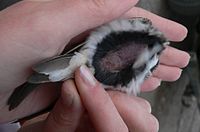
Photo from wikipedia
The eggs of avian obligate brood-parasitic species have multiple adaptations to deceive hosts and optimize development in host nests. While the structure and composition of the eggshell in all birds… Click to show full abstract
The eggs of avian obligate brood-parasitic species have multiple adaptations to deceive hosts and optimize development in host nests. While the structure and composition of the eggshell in all birds is essential for embryo growth and protection from external threats, parasitic eggs may face specific challenges such as high microbial loads, rapid laying and ejection by the host parents. We set out to assess whether eggshells of avian brood-parasitic species have either (i) specialized structural properties, to meet the demands of a brood-parasitic strategy or (ii) similar structural properties to eggs of their hosts, due to the similar nest environment. We measured the surface topography (roughness), wettability (how well surfaces repel water) and calcium content of eggshells of a phylogenetically and geographically diverse range of brood-parasitic species (representing four of the seven independent lineages of avian brood-parasitic species), their hosts and close relatives of the parasites. These components of the eggshell structure have been demonstrated previously to influence such factors as the risk of microbial infection and overall shell strength. Within a phylogenetically controlled framework, we found no overall significant differences in eggshell roughness, wettability and calcium content between (i) parasitic and non-parasitic species, or (ii) parasitic species and their hosts. Both the wettability and calcium content of the eggs from brood-parasitic species were not more similar to those of their hosts' eggs than expected by chance. By contrast, the mean surface roughness of the eggs of brood-parasitic species was more similar to that of their hosts’ eggs than expected by chance, suggesting brood-parasitic species may have evolved to lay eggs that match the host nest environment for this trait. The lack of significant overall differences between parasitic and non-parasitic species, including hosts, in the traits we measured, suggests that phylogenetic signal, as well as general adaptations to the nest environment and for embryo development, outweigh any influence of a parasitic lifestyle on these eggshell properties.
Journal Title: Royal Society Open Science
Year Published: 2023
Link to full text (if available)
Share on Social Media: Sign Up to like & get
recommendations!